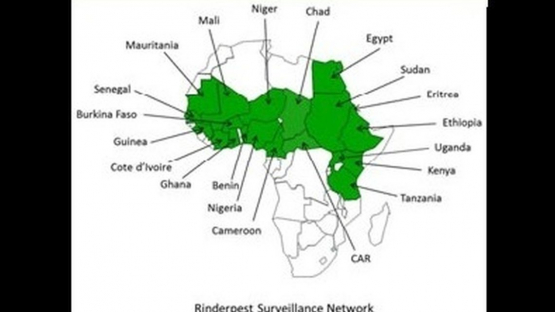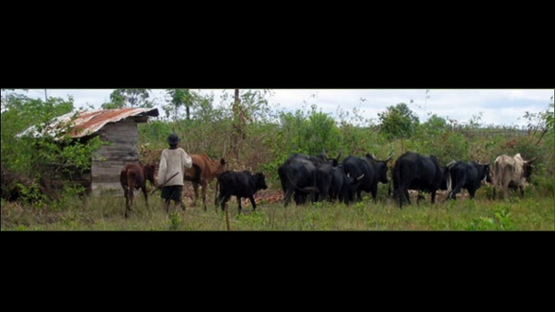Rinderpest, also known as cattle plague, has been responsible for immense livestock losses throughout history. First described in Europe in 1712, it reached Africa in 1850, where it killed millions of cattle and wild animals, and caused widespread starvation. Initially controlled through a policy of ‘stamping-out’ (slaughter of all infected or exposed animals), it was later brought under control by vaccination, which has been key to its eradication in Africa. Middle East and Asia. This required the development and deployment of diagnostic tests to determine where the disease was, where it was spreading to, which animals were infected and/or at risk and, most importantly, to monitor the efficiency of the vaccination campaigns. The continent-wide implementation of immunoassay technology has provided the technological platform to monitor national vaccination programmes of the Pan African Rinderpest Eradication Campaign (PARC) to save animals from the disease and has led to an annual economic benefit to the region estimated at US $920 million.

If you would like to learn more about the IAEA’s work, sign up for our weekly updates containing our most important news, multimedia and more.
Global Rinderpest Eradication: The IAEA Contribution
Countries suffering from the ravages of rinderpest, a highly contagious viral disease of cattle, buffalo, yak and several wildlife species, were officially recognised as disease free by the World Organisation for Animal Health (OIE) in May 2011 and FAO in June 2011 when they declared that rinderpest was eradicated world-wide.
The International Atomic Energy Agency (IAEA), together with the Food and Agriculture Organization of the United Nations (FAO) and the OIE, has made significant technical contributions to this achievement through the development, evaluation, validation and distribution of immunological and molecular nuclear and nuclear-related technologies for the diagnosis and control of rinderpest.
Motivated by the IAEA’s contribution towards the eradication of Rinderpest, a “Rinderpest Freedom Celebration” was held on 20 September 2011, during the IAEA 55th General Conference in Vienna. More than 200 observers have attended the event and representatives of different international organizations (Director General of the IAEA, Mr. Yukita Amano, the Deputy Director General of the Food and Agricultural Organization, Ms. Ann Tutwiler, the Deputy Director of the World Organization for Animal Health, Mr. Kazuaki Miyagishima, the Director of the African Union-IBAR, Mr. Ahmed El Sawalhy), as well as the Ambassadors of Kenya, Italy and India, have given plenary talks of appreciation to the critical role that the IAEA has played during this campaign. The Animal Production and Health Subprogramme of the Joint FAO/IAEA Centre and the Technical Cooperation Department have developed, evaluated, validated, transferred and maintained nuclear and nuclear related diagnostic technologies in FAO and IAEA Member States. The IAEA worldwide diagnostic laboratory network was one of the critical cogs in the drive to control and eliminate rinderpest. This diagnostic laboratory network that was established to fight rinderpest, forms now the basis of our campaign to control other transboundary animal diseases such as Peste des Petite Ruminants.


To address the field diagnosis and control of livestock from this deadly disease, the Enzyme Linked Immunosorbent Assay (ELISA) platform was developed in the early 1980s mainly through IAEA support. This ELISA technology evolved from a radioisotope immuno assay research tool into an affordable nuclear related diagnostic laboratory technology. The rinderpest ELISA was developed in stages. Initially an indirect test (i-ELISA) was used to detect antibodies to rinderpest in infected or vaccinated cattle. Later, with the development of monoclonal antibodies, a highly specific competitive ELISA (c-ELISA) for detecting antibodies was deployed. This had advantages over the indirect test in terms of standardization, applicability to different livestock and wildlife species, as well as increased reliability and quality assurance parameters. Finally, an immunocapture ELISA was developed that could be used to detect viral antigen in pathological samples or exudates from affected animals. This assay was able to distinguish between rinderpest and another virus, peste des petits ruminants, enabling unequivocal identification of rinderpest infection.
Easy to use ELISA kits were provided with control reagents and a protocol containing a list of the essential equipment required to conduct the assay. These kits were specifically designed for use in laboratories in countries participating in the Pan African Rinderpest campaign (PARC) which covered 34 countries. A strict bench protocol ensured a standard level of assay performance within and between laboratories. The protocol also described reagent preparation, handling and use, as well as details of data management and interpretation.
For the sero-monitoring strategy to work, institutional linkages were essential. Through its technical cooperation programme, the IAEA trained national veterinary staff across Africa in the use of ELISA as a monitoring tool, and supported the establishment of a feedback system. Software programmes, specifically written for the Joint FAO/IAEA Centre in support of the rinderpest sero-monitoring facilitated data acquisition, processing, management, interpretation and reporting, as well as quality assurance. In addition, an external quality assurance programme with check sample panels facilitated international certification of laboratory performance using the ELISA kit or its equivalent. Today, most technical support for sero-monitoring in Africa is provided by national staff trained by the IAEA. These tools and techniques developed for PARC were also used in the West Asian and South Asian Rinderpest Eradication Campaigns as well by FAO’s field implementation activities of the Global Rinderpest Eradication Programme (GREP).
Technical cooperation: an example

A 1997 initiated regional project aimed to increase food security and improve rural economies in Africa through the eradication of rinderpest from the continent by 2002, and to have previously affected countries recognized as officially disease-free by internationally sanctioned veterinary and trade organizations. Working closely with other international and regional organizations involved in rinderpest eradication efforts in Africa, particularly in connection with the Pan African Eradication Campaign (PARC), the IAEA conducted five regional workshops/training courses on harmonisation of livestock development policies, rinderpest surveillance and emergency preparedness, quality control issues of the rinderpest ELISA, and ELISA troubleshooting.
Performance Indicators as well as Standard Operating Procedures (SOPs) for rinderpest sero-monitoring, sero-surveillance and related Quality Assurance aspects were completed and published, as was an international agreement on standards for the accreditation of veterinary laboratories for trade purposes.
All participating Member States were accredited by the OIE as rinderpest infection free in 2010. National rinderpest surveillance systems were reviewed in these Member States, and the laboratory protocol for the competitive Rinderpest ELISA was used for this important achievement RAF/5/043: Assistance to Complete Eradication of Rinderpest from Africa RAF/5/053: Assistance to OAU/IBAR PACE Programme for the Control and Eradication of Major Diseases Affecting Livestock

